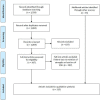How to Value Orphan Drugs? A Review of European Value Assessment Frameworks
- PMID: 34054519
- PMCID: PMC8150002
- DOI: 10.3389/fphar.2021.631527
How to Value Orphan Drugs? A Review of European Value Assessment Frameworks
Abstract
Background: Decision-makers have implemented a variety of value assessment frameworks (VAFs) for orphan drugs in European jurisdictions, which has contributed to variations in access for rare disease patients. This review provides an overview of the strengths and limitations of VAFs for the reimbursement of orphan drugs in Europe, and may serve as a guide for decision-makers. Methods: A narrative literature review was conducted using the databases Pubmed, Scopus and Web of Science. Only publications in English were included. Publications known to the authors were added, as well as conference or research papers, or information published on the website of reimbursement and health technology assessment (HTA) agencies. Additionally, publications were included through snowballing or focused searches. Results: Although a VAF that applies a standard economic evaluation treats both orphan drugs and non-orphan drugs equally, its focus on cost-effectiveness discards the impact of disease rarity on data uncertainty, which influences an accurate estimation of an orphan drug's health benefit in terms of quality-adjusted life-years (QALYs). A VAF that weighs QALYs or applies a variable incremental cost-effectiveness (ICER) threshold, allows the inclusion of value factors beyond the QALY, although their methodologies are flawed. Multi-criteria decision analysis (MCDA) incorporates a flexible set of value factors and involves multiple stakeholders' perspectives. Nevertheless, its successful implementation relies on decision-makers' openness toward transparency and a pragmatic approach, while allowing the flexibility for continuous improvement. Conclusion: The frameworks listed above each have multiple strengths and weaknesses. We advocate that decision-makers apply the concept of accountability for reasonableness (A4R) to justify their choice for a specific VAF for orphan drugs and to strive for maximum transparency concerning the decision-making process. Also, in order to manage uncertainty and feasibility of funding, decision-makers may consider using managed-entry agreements rather than implementing a separate VAF for orphan drugs.
Keywords: decision-making; economic evaluation; fairness; health technology assessment (HTA); multi-criteria decision analysis (MCDA); orphan drug; rare disease; value assessment framework.
Copyright © 2021 Blonda, Denier, Huys and Simoens.
Conflict of interest statement
SS has previously conducted research about market access of orphan drugs sponsored by the Belgian Health Care Knowledge Centre and by Genzyme (now Sanofi), and he has participated in an orphan drug roundtable sponsored by Celgene. SS is a member of the ISPOR Rare Disease Special Interest Group's Challenges in Research and Health Technology Assessment of Rare Disease Technologies Working Group, the International Working Group on Orphan Drugs, and the Innoval Working Group on Ultra-Rare Disorders. The remaining authors declare that the research was conducted in the absence of any commercial or financial relationships that could be construed as a potential conflict of interest.
Figures
Similar articles
-
How Can We Optimize the Value Assessment and Appraisal of Orphan Drugs for Reimbursement Purposes? A Qualitative Interview Study Across European Countries.Front Pharmacol. 2022 Jul 19;13:902150. doi: 10.3389/fphar.2022.902150. eCollection 2022. Front Pharmacol. 2022. PMID: 35928274 Free PMC article.
-
Implementing reflective multicriteria decision analysis (MCDA) to assess orphan drugs value in the Catalan Health Service (CatSalut).Orphanet J Rare Dis. 2019 Jun 27;14(1):157. doi: 10.1186/s13023-019-1121-6. Orphanet J Rare Dis. 2019. PMID: 31248421 Free PMC article.
-
Multi-Criteria Decision Analysis (MCDA) Models in Health Technology Assessment of Orphan Drugs-a Systematic Literature Review. Next Steps in Methodology Development?Front Public Health. 2018 Oct 15;6:287. doi: 10.3389/fpubh.2018.00287. eCollection 2018. Front Public Health. 2018. PMID: 30374435 Free PMC article.
-
Assessing the Value of Nusinersen for Spinal Muscular Atrophy: A Comparative Analysis of Reimbursement Submission and Appraisal in European Countries.Front Pharmacol. 2022 Jan 21;12:750742. doi: 10.3389/fphar.2021.750742. eCollection 2021. Front Pharmacol. 2022. PMID: 35126102 Free PMC article. Review.
-
International experiences in multicriteria decision analysis (MCDA) for evaluating orphan drugs: a scoping review.Expert Rev Pharmacoecon Outcomes Res. 2019 Aug;19(4):409-420. doi: 10.1080/14737167.2019.1633918. Epub 2019 Jul 1. Expert Rev Pharmacoecon Outcomes Res. 2019. PMID: 31210065
Cited by
-
How to balance valuable innovation with affordable access to medicines in Belgium?Front Pharmacol. 2022 Sep 16;13:960701. doi: 10.3389/fphar.2022.960701. eCollection 2022. Front Pharmacol. 2022. PMID: 36188534 Free PMC article.
-
How Can We Optimize the Value Assessment and Appraisal of Orphan Drugs for Reimbursement Purposes? A Qualitative Interview Study Across European Countries.Front Pharmacol. 2022 Jul 19;13:902150. doi: 10.3389/fphar.2022.902150. eCollection 2022. Front Pharmacol. 2022. PMID: 35928274 Free PMC article.
-
Development of the Emirates Multi-Criteria Decision Analysis Tool for Orphan Drugs.Cureus. 2024 Feb 29;16(2):e55215. doi: 10.7759/cureus.55215. eCollection 2024 Feb. Cureus. 2024. PMID: 38558740 Free PMC article.
-
Clinical and non-clinical aspects of reimbursement policy for orphan drugs in selected European countries.Front Pharmacol. 2024 Nov 19;15:1498386. doi: 10.3389/fphar.2024.1498386. eCollection 2024. Front Pharmacol. 2024. PMID: 39629081 Free PMC article.
-
Evaluating the national system for rare diseases in China from the point of drug access: progress and challenges.Orphanet J Rare Dis. 2022 Sep 10;17(1):352. doi: 10.1186/s13023-022-02507-2. Orphanet J Rare Dis. 2022. PMID: 36088349 Free PMC article.
References
-
- Aho E., Johansson P., Uddén A., Zhao de Gosson de Varennes Y., Rasmuson S., Rönholm G. (2017). The development of pharmaceutical expenditure in Sweden. Stockholm, Sweden: Dental and Pharmaceutical Benefits Agency.
-
- Angelis A., Kanavos P. (2016). Value-based assessment of new medical technologies: towards a robust methodological framework for the application of multiple criteria decision analysis in the context of health technology assessment. Pharmacoeconomics 34 (5), 435–446. 10.1007/s40273-015-0370-z - DOI - PMC - PubMed
Publication types
LinkOut - more resources
Full Text Sources
Other Literature Sources


